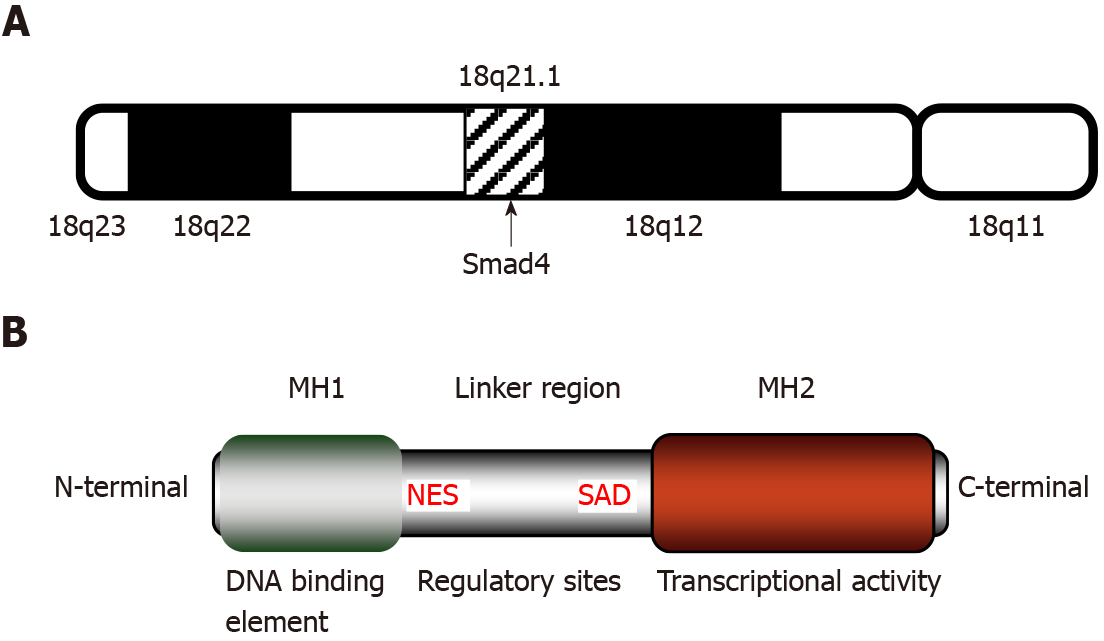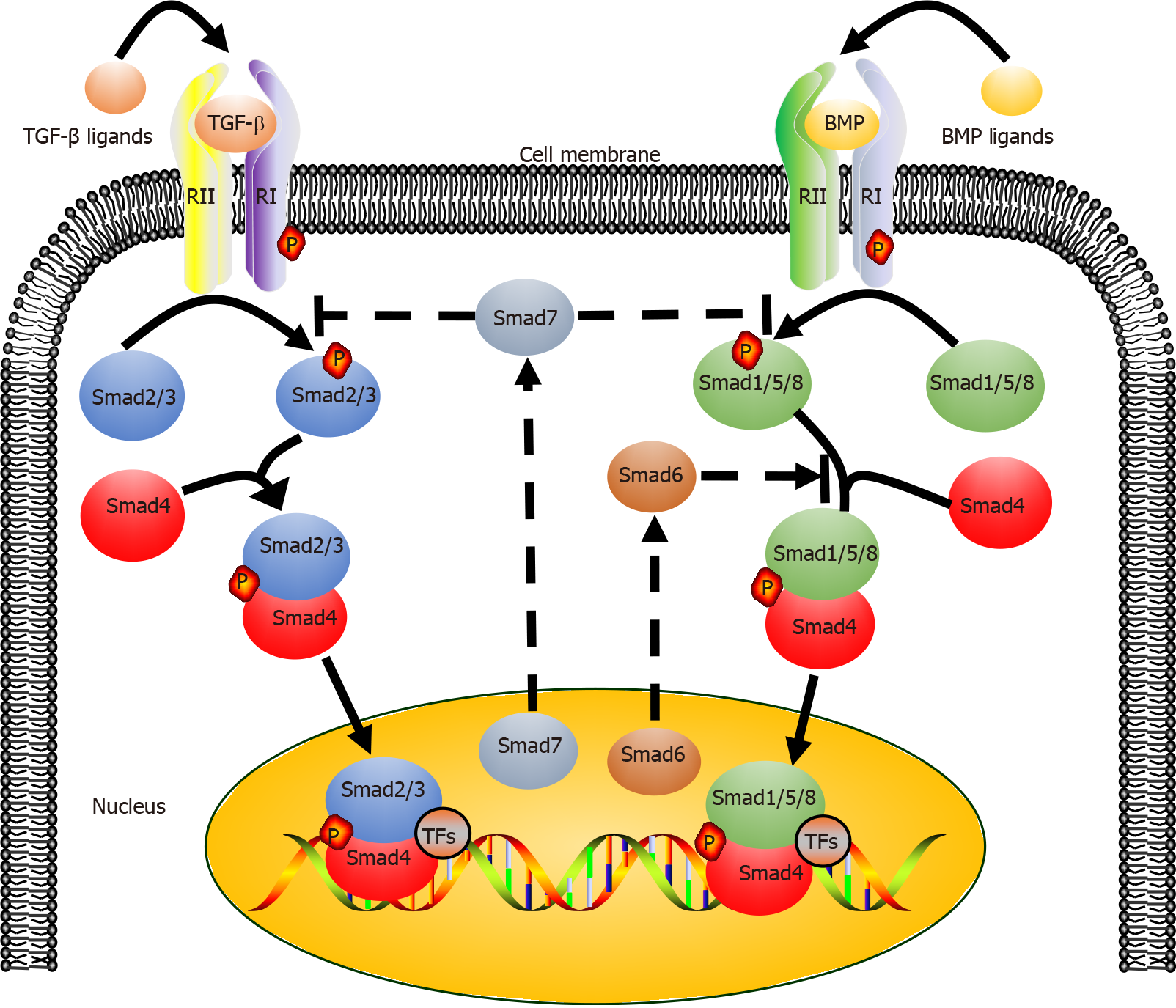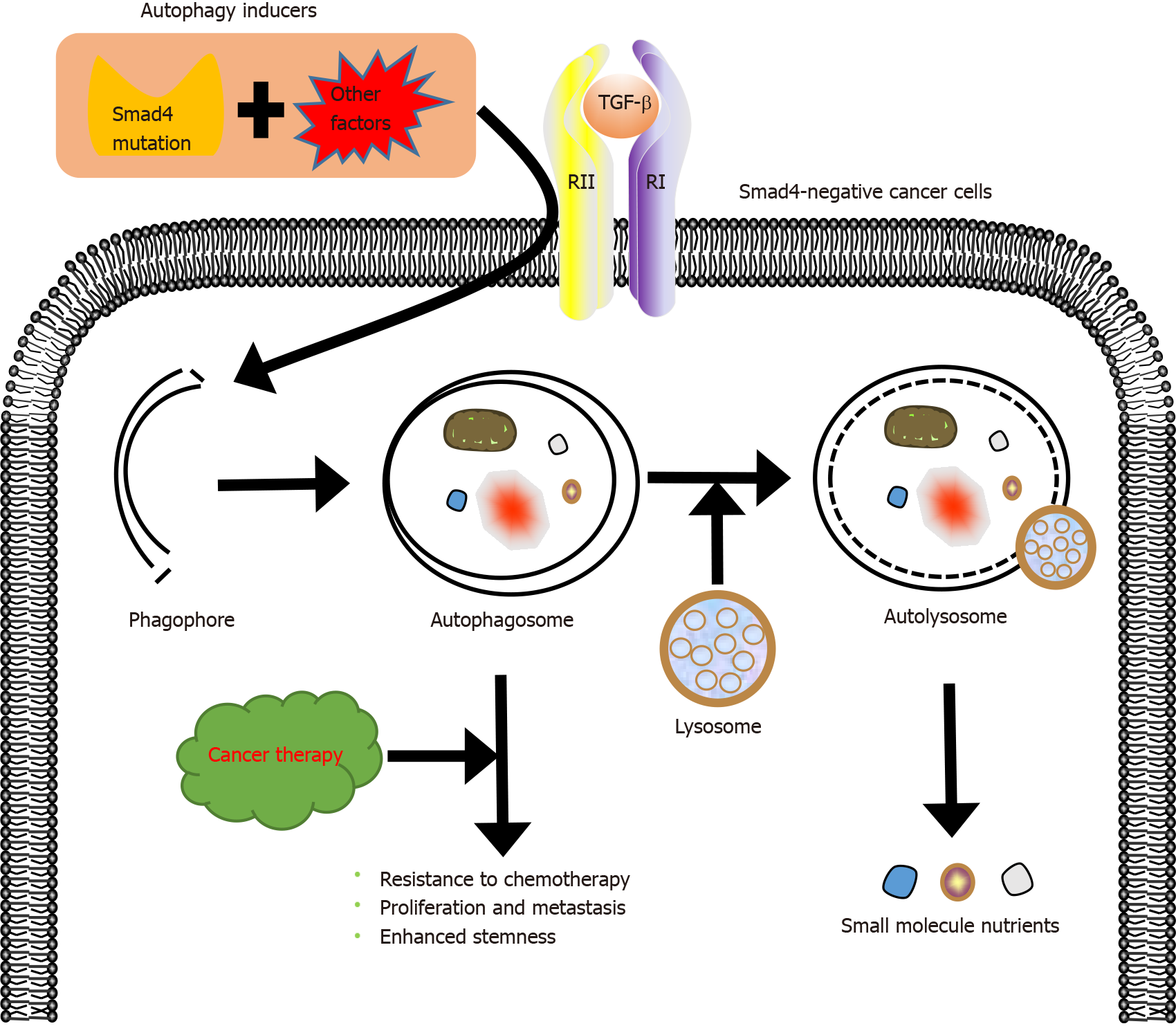Copyright
©©The Author(s) 2022.
World J Stem Cells. Jan 26, 2022; 14(1): 41-53
Published online Jan 26, 2022. doi: 10.4252/wjsc.v14.i1.41
Published online Jan 26, 2022. doi: 10.4252/wjsc.v14.i1.41
Figure 1 Structure and features of mothers against decapentaplegic homolog 4.
A: Location of the mothers against decapentaplegic homolog 4 (Smad4) gene. Smad4 is located at q21.1 of human chromosome 18; B: Structural diagram of Smad4 protein. Smad4 protein consists of three domains: Mad homology domain 1 (MH1) at the N-terminal, MH2 at the C-terminal, and the linker region connecting MH1 and MH2. Functionally, MH1 is responsible for binding to the Smad-binding site, and MH2 is indispensable for transforming growth factor-β transcriptional activity. The middle linker is rich in regulatory sites controlling various signaling pathways and kinases and is essential for the regulation of transcriptional activity. MH1: Mad homology domain 1; MH2: Mad homology domain 2; NES: Nuclear export signal; SAD: Smad activation domain; Smad4: Mothers against decapentaplegic homolog 4.
Figure 2 Transforming growth factor-β/mothers against decapentaplegic homolog 4 and bone morphogenetic protein/mothers against decapentaplegic homolog signaling pathways.
Activated transforming growth factor-β (TGF-β) ligands or bone morphogenetic protein ligands bind to type II receptor (TβRII) on the cell membrane and recruit type I receptors (TβRI), forming receptor complexes (TβRI and TβRII). Phosphorylated receptor complexes phosphorylate mothers against decapentaplegic homolog (Smad)2/3 and Smad1/5/8 (R-Smads). Smad4 (Co-Smad) binds with R-Smads to form two different complexes (Smad4/Smad2/3 and Smad4/Smad1/5/8). The heteromeric complexes are translocated to the nucleus, where they regulate the expression of specific genes. Smad6 and Smad7 (I-Smads), which are typically located in the nucleus, can enter the cytoplasm upon activation and regulate the transcriptional activity of the TGF-β signaling pathway. Smad6 mainly competes with R-Smads for binding Smad4 to inhibit transcriptional activity, while Smad7 inhibits transcriptional activity mostly by preventing the phosphorylation of R-Smads. BMP: Bone morphogenetic protein; TFs: Transcription factors; Smad1-8: Mothers against decapentaplegic homolog 1-8; TGF-β: Transforming growth factor-β.
Figure 3 Different roles of mothers against decapentaplegic homolog 4 in the development of hepatocellular carcinoma and pancreatic cancer.
A: The role of Smad4 in liver carcinogenesis. During the development of hepatocellular carcinoma, the transcriptional activity of mothers against decapentaplegic homolog 4 (Smad4) is abnormally increased, and in combination with gene mutations, alcohol, pathogen infection, as well as other carcinogenic factors, contributes to the loss of cell cycle control, suppression of DNA damage repair, increased proliferation, and decreased apoptosis. These factors result in a higher metastatic ability of cancer cells and poor patient prognosis; B: The role of Smad4 in pancreatic carcinogenesis. During pancreatic cancer progression, the deletion or mutation of Smad4 leads to loss of Smad4 activity. The absence of Smad4 function, together with other carcinogenic factors such as gene mutations and pancreatic tissue injury, results in the loss of cell cycle control, suppression of DNA damage repair, increased proliferation, and decreased apoptosis. These factors result in a higher metastatic ability of cancer cells and poor patient prognosis. Smad4: Mothers against decapentaplegic homolog 4.
Figure 4 Role of mothers against decapentaplegic homolog 4 in autophagy and drug resistance induced by transforming growth factor-β.
In cancer cells with decreased or absent expression of mothers against decapentaplegic homolog 4 (Smad4) (Smad4-negative cancer cells), Smad4 mutation combined with other autophagy inducing factors (autophagy inducers) activates autophagy via the transforming growth factor-β signaling pathway, so that cancer cells can obtain nutrition through autophagy, develop resistance to chemotherapy, and show enhanced proliferation, metastasis, and stemness. Smad4: Mothers against decapentaplegic homolog 4; TGF-β: Transforming growth factor-β.
- Citation: Dai CJ, Cao YT, Huang F, Wang YG. Multiple roles of mothers against decapentaplegic homolog 4 in tumorigenesis, stem cells, drug resistance, and cancer therapy. World J Stem Cells 2022; 14(1): 41-53
- URL: https://www.wjgnet.com/1948-0210/full/v14/i1/41.htm
- DOI: https://dx.doi.org/10.4252/wjsc.v14.i1.41












